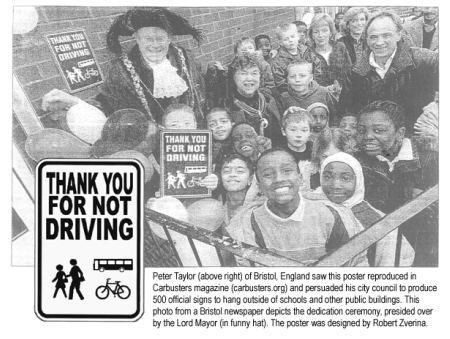4Culture is helping to fund artists to work with a Low Impact Vehicle exploration (aLIVe). The deadline was January.
Here’s the pitch:
A Low Impact Vehicle exploration, invites artists to submit ideas that will inspire and engage the broader community in a conversation about transportation. Produced in collaboration with artist Cheryl dos Remedios and Great City, the project seeks artists’ thinking in solving energy, transportation and livability issues facing us all.
Following the application deadline, a selection panel of experts from the fields of art, applied design, technology, public health and transportation selected eight ideas for implementation of “low impact vehicle” design from a field of 21 submitted applications.
Here are the winners:
Michelle
Arab: A series of drawings made from sediment and debris collected
from
catch basin filter inserts into the storm drain system.Vaughn
Bell: Sculptural walking sticks and a series of performances that
reinforce
the sensory experience of the traveler and the notion that the ultimate
low
impact vehicle is the human body.Julia
Field, Undriving.org: A series of 6 short documentary videos that
chronicle
the choices made by individuals who have made an Undriving pledge and
received
their Undriver License.
Melissa
Glenn and Matt Inpanbutr: Bi(K) o garten – a kit that transforms
parking spaces into a temporary “park.”Michael
Hintze, Alisha Dall’Osto, David R. Dall’Osto and Nadine Smith:
Magnetic Mass Assist table-top model that illustrates a mechanism to
harness
the kinetic energy of descending vehicles to assist the riders going up
the
hill, making bikes more practical for a wider range of riders on steep
Seattle
terrain.
Dominic
Muren: Production Cycle, a mobile, micro-factory in the form of a
pedal-powered sewing machine. Muren will make reusable cloth shopping
bags for give-aways at local farmers markets. The currency for the bags
will be information about other waste stream products that can be
recycled into
goods. A website that employs Google mapping technology will illustrate
the sources of all contributed recycled materials.Johnnie
Olivan: A fleet of 6-8 “Bike-Cars” that are constructed from
reclaimed bikes and other materials and designed to offer pedal-powered
alternatives for transporting goods and people.
Stokley
Towles: A one-person performance and temporary exhibition based on
interviews with individuals involved in transportation infrastructure
design,
storm water systems and public perception and behavior research. The
goal
of the project is to stimulate ways for the public to engage in
“transpiration” – re-imagining how we travel around the city.
Some of these ideas seem too goofy for words. Others, substantial. Familiar with the work of a few, I’m in no position to assess. One thing strikes me, however. In Seattle, there is one artist who stands way above all others in his examination of a non-car life: Robert Zverina. If he didn’t apply, shouldn’t somebody at some point in the process have asked him to? This grant had his name on it.




Thanks, Regina, for the vote of confidence. A few different folks did send the application my way but the truth is I have given up on applying for grants. Maybe this one was different and I should have applied, but I’ve wasted too much time on “sure-thing” applications in the past few years. The whole process is just too arbitrary and degrading. It’s a battle I’ve chosen not to fight.
I’d love to see someone in the new city administration take up the THANK YOU FOR NOT DRIVING design and make some official signs as they did in Bristol, England. I pitched it previously when Nickels was the big boy and it went nowhere.
For those who are interested, I have a new-ish blog devoted to Carfree living in Seattle: http://carfreeseattle.blogspot.com/
…Oh, and I was misled by the name of the call for proposals. ALIVe is a clever acronym but a Vehicle is not necessary for transportation–walking works pretty well. That turned me off right there and revealed certain assumptions about mobility which I found alienating. Also, A Low-Impact Vehicle exploration called to my mind an engineering challenge, not a call to artists. So I thought they were looking for something more substantial and practical than I had ready to offer.
Note to funding organizations: don’t sacrifice clarity to cleverness. For that, there’s this: http://acrony.com/